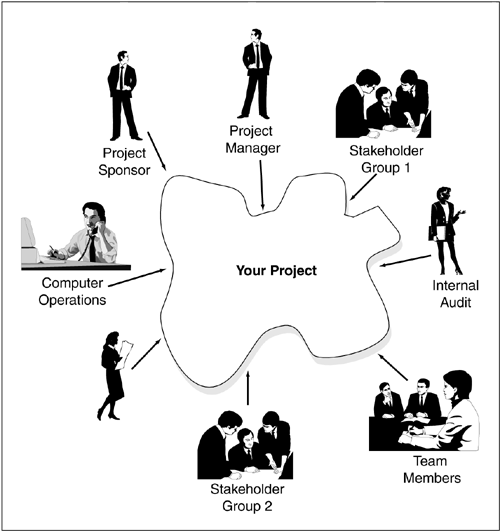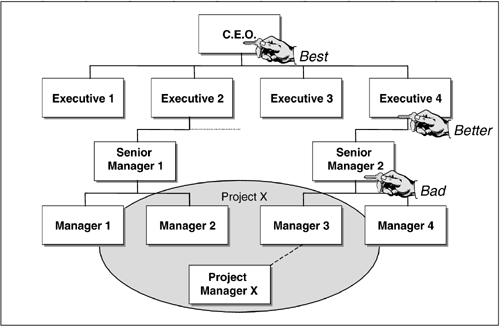Rule 1: The Bag of Money and the Baseball Bat
| This rule is the most important of all the rules we are covering in this chapter. The management of contemporary business and IT projects involves many stakeholders and service providers. For the project manager, the need for a sponsor who can assist in the resolution of the inevitable conflicts that arise throughout the proj-ect is critical. A simple example comes from the area of project scope and objectives. We have seen this issue on literally every project that our group has been involved with. As shown in Figure 20.1, it is likely that each of the represented stakeholder groups will see the scope and objectives of the project differently. The project team members supported by the members of Stakeholder Groups 1 and 2 agree that process and system documentation can be added after implementation and is therefore out of scope. However, internal audit and the system support groups strongly disagree with this position. Clearly, it is part of the project manager's role to negotiate between these stakeholders and attempt to find some resolution through compromise. However, should this fail, the project manager must be able to escalate or "push back" the problem to a person who can make a unilateral decision as to whether project documentation is in or out of scope. Figure 20.1. The stakeholder environment Here the "bag of money and the baseball bat" test becomes relevant. The bag of money refers to the level of authorization of spending available to the project sponsor. Simply, the larger the authorization level for spending available to the sponsor, the more corporate power the sponsor has to wield . If the person appointed as the project sponsor is, in fact, paying for the project from his or her budget, he or she would typically have the authority and authorization to decide unilaterally [3] whether project documentation was required or not.
However, should the person who has been allocated the sponsor role not have the appropriate level of financial authority and authorization, then he or she would most likely "pass the buck" either back to the project manager or upward to the person with the authority. Either action results in delays in problem resolution and delays to the project. The baseball bat refers to the level of organizational and political power available to the project sponsor. The bag of money and the baseball bat are often linked together, but in many cases, there is a more complex relationship. For example, although the project sponsor may not have the financial authority, he or she may have the organizational authority. Although organizational authority typically is associated with the level of organizational position, the project sponsor may have additional organizational power through his or her use of allies , powerful mentors, personal charisma, and so on. A "bright star" may have more organizational power than other people at the same organizational level. What is important here is your project sponsor's ability to use his or her organizational power (i.e., their baseball bat) to assist you in resolving project conflicts. As shown in Figure 20.2, the simple rule here is that the best sponsor is the one with the biggest bat and bag of money. Project X crosses organizational boundaries between Executive 2 and Executive 3. If Senior Manager 2 was delegated the project sponsor role, then, it would be unlikely for that person to have either the right level of "bat" or "bag of money" to resolve conflicts between stakeholders in Executive 2 and 3 areas. Figure 20.2. The hierarchy of bats This inappropriate level of delegation would inevitably result in one of two results: At best, it would result in project delays, as the sponsor would need to pass decisions upward to the person with the right level of authority and power. At worst, it would result in the problem being left for the project manager to solve. As many experienced project managers have found, attempts to solve boundary disputes without an effective power base typically result in the project becoming mired in a series of political battles between different stakeholder groups. One thing we have learned about senior executives is that they love using their baseball bats. All you have to do is to show them where to swing it. |
EAN: 2147483647
Pages: 136

